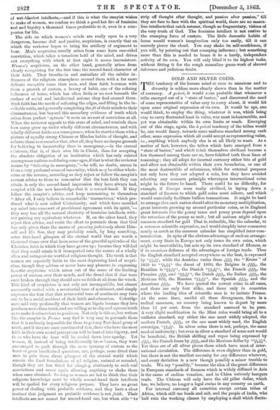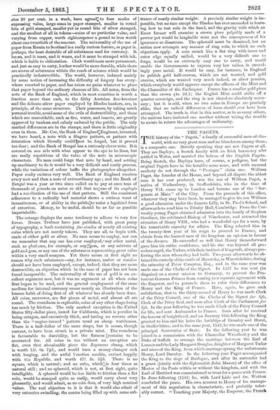GOLD AND SILVER COINS.
THE tendency of the human mind at once to sameness and to diversity is seldom more clearly shown than in the matter of currency. el priori, it would seem probable that whenever a tribe emerged out of a " state of barter," and discovered the need of some representative of value easy to oarry about, it would hit upon some original expression of its own. It would be apt, one would think, to employ the thing, whatever it was, which being easy to carry fluctuated least in value, was most indestructible, and yet was obtainable within its own limits or reach. Emerging out of this stage, again, the a priori tendency of the tribes would be, one would fancy, towards some uniform standard among each other, some expression which all could accept as representing value, i.e., anything which anybody else is at all likely to want. As a matter of fact, however, the tribes which have emerged from a "state of barter," and which think themselves civilized because a few thousand among them are so, have falsified both these lines of reasoning ; they all adopt for internal currency either bits of gold and silver not obtainable within their own boundaries, or one of the most destructible of substances, while for external purposes not only have they not adopted a coin, but they have avoided selecting any common principle whereupon international coins might in the future be based. There could be no difficulty, for example, if Europe were really civilized, in laying down a standard of fineness to which gold coins must adhere, and which would materially facilitate bullion transactions. It might be hard to arrange that each nation should alter its monetary multiplication, great interests growing up around particular coins, as in England great interests like the penny taxes and penny press depend upon the retention of the penny as unit ; but all nations might adopt a common standard for gold- That is, reducible, like the calendar, to a common scientific expression, and would simplify inter-commerce nearly as much as the common calendar has simplified inter-com- munication. In spite of the obvious advantage of such an arrange- ment, every State-in Europe not only issues its own coins, which might be unavoidable, but sets up its own standard of fifieness, as if in conscious defiance of the advantages of foreign trade. Thus the English standard accepted everywhere as the best, is expressed by 9 + heu9 while the Austrian varies from Saab the " Krone " of 1859 to 9 BA trP the ducat of 1860, the Belgian is T9, the Brazilian is 9+,6,-A97, the Danish ely3, the French 4,6 the Prussian and ..igo7073, the Dutch 9,43„, the Italian ifulfb., the Mexican 876, the Russian 9+STAP 7, the Spanish, and the American ,808.00. We have quoted the newest coins in all cases, and there are only four alike, and those only in countries where the leading idea of scientific men is to imitate France. At the same time, amidst all these divergences, there is a radical sameness, no country being known to depart by more than 12 per cent. from the standard assumed to be pure. A very slight modification in the Mint rules would bring all to a uniform standard, say either the one most widely adopted, the modern French, TVA or the one most widely used, the English sovereign, 04S-N. In silver coins there is not, perhaps, the same need of uniformity; but even in silver a standard of some sort would be beneficial, the British shilling and rupee being expressed by T9uauSty the French franc by ,9„1,90., and the Mexican dollar by 9 °T90 -ZT :a' . Yet these are of all silver pieces those which have most of inter- national circulation. The difference is even slighter than in gold, but there is not the smallest necessity for any difference whatever, and every deviation is a new though possibly a minor trouble to trade. We say "possibly," because the idea of the great difference in European standards of fineness which is widely diffused in Asia is the cause of endless vexation, and in China seriously hampers trade. The Chinese will only have the old pillar dollar, which has, we believe, no longer a legal status in any country on earth.
For internal currency all countries except certain tribes of Africa, which still use beads and salt, and the people of India, who half ruin the working classes by employing a shell which fluctu-
ates 20 per cent. in a week, have agreed: to four modes of expressing value, large sums in paper stamped, smaller in round
bits of gold stamped, smaller yet in round bits of silver stamped, and the smallest of all in tokens—coins of no particular value, and varying from copper, worth eighteenpence a pound to iron worth about one-twentieth of the amount. The universality of the use of paper from Russia to Scotland is a really curious feature, as paper is, perhaps, the least desirable of all substances used for currency. It burns, and it tears, and it wears, and it must be stamped with ink, which is liable to obliteration. Cloth would seem more permanent, and just as easy to carry, leather would be more durable, while there are scores of substances within the reach of science which would be practically indestructible. The world, however, induced mainly by some notion of increasing the difficulty of forgery has every- where resorted to paper, and has taken no pains whatever to place that paper beyond the ordinary chances of life. All notes, from the note of the Bauk of England, which in most countries is worth a fraction more than cash, to the filthy Austrian five-kreutzer and the delicate silver paper employed by Hindoo bankers, are, in principle, of the same structure. Their possessors, by taking much personal trouble, avoid some of the evils of destructibility, and those which are unavoidable, such as fire, water, and insects, are greatly approved by bankers and calmly endured by the public. The only marked differences are in the stamps, and there is little originality even in them. Mr. Coe, the Bank of England:Engineer, invented, we have heard, a note with a filagree pattern, or pattern with interstices which literally could Enot be forged, but it proved too dear ; and the Bank of Bengal has a curiously clever note. It is covered on one side with what appear to the eye to be lines, but are really repetitions of the value of the note in microscopic characters. No man could forge that note by hand, and setting up machinery to do it would be a very difficult and costly process, while the variations of colour baffle the photographer altogether. Paper really endures very well. The Bank of England receives every now and then a note of extraordinary age ; and the Bank of Bengal was a year or two since called on to pay at once tens of thousands of pounds on notes so old that no:one of its employgs had a recollection of the use of that pattern. Still the consistent adherence to a radically bad material shows a curious want of inventiveness, or of ability in the publicto resist a legalized form of extortion. Money, to be useful, should be as far as possible imperishable.
The coinage displays the same tendency to adhere to very few forms. Messrs. Trubner have just published, with great pomp of typography, a book containing facsimiles of nearly all existing coins which are not merely tokens. They are all, to begin with, made of either gold or silver. No race seems to employ, nor can we remember that any one has ever employed,- any other metal, such as platinum, for example, or anyrgem, or any mixture of
gold and gem, or any one of the substances representing great value within a very small compass. Yet there seems at first sight no reason why such substances—say, for instance, amber or coral—
should not have been employed, except, indeed, that they are more destructible, an objection which in the case of paper has not been found insuperable. The universality of the use of gold is an ex- cellent argument now, but it was no argument at all when coins first began to be used, and the general employment of the same medium for internal currency seems merely an illustration of the human habit of doing first of all whatever has already been done.
All coins, moreover, are flat pieces of metal, and almost all are round.' The roundness is explicable, coins of any other shape losing too much by friction. The only marked exception is the United States fifty-dollar piece, issued for California, which is peculiar in being octagon, and excessively thick, and having no reverse other than the " engine-turned " pattern usual on cheap watchcases. There is a half-dollar of the same shape, but it seems, though current, to have been struck in a private mint. The roundness
is favourable to durability, but the flatness Eremains to be
accounted for. All coins in use without an exception are flat, even that abominable piece the Japanese obang, which is worth 151. Os. 7kd., and would turn a money-changer sick with longing, and the awful Venetian zecchin, extinct happily with the Republic, and worth 471. 5s. 51d. There is no square, which is natural ; and no cube, whiclels four times as natural still ; and no spheroid, which is not, at first sight, quite intelligible. A spheroid would be less liable to friction than a flat coin, would be stamped quite as easily, would carry about very pleasantly, and would admit., as no coin does, of very high nominal values. The real objection to it is that it would also admit of very extensive swindling, the centre being filled up with some sub- stance of nearly similar weight. A precisely similar weight is im- possible, but no race except the Hindoo has ever succeeded iu learn- ing how to test coin in the hand, and the gravity with which an Essex farmer will examine a crown piece palpably made of a pewter pot would be laughable were not the consequences of his ignorance so disastrous. The spheroid must be dismissed, but no nation now attempts any manner of ring coin, to which no such objections apply. A coin struck like a flat ring with inner and outer edge equally milled, would be a very difficult one to forge, would be an extremely easy one to carry, and would enable the Governments to express very low values in exceed- ingly pure metal. It would be easy, for instance, in England to publish gold half-crowns, which are not wanted, and gold crowns, which are wanted very much indeed, or silver pennies, which everybody would approve except the officers of the Mint and the Chancellor of the Exchequer. France has a smaller gold piece than the crown (4s. 2d.) ; the English Mint could strike off a quarter sovereign, and the ring is not therefore absolutely neces- sary ; but it is odd, when no two coins in Europe are precisely alike, that no radical differences of form should ever have been attempted. The truth is, that in this matter, as in so many others, the nations have imitated one another without taking the trouble to secure in return the advantages of uniformity.































 Previous page
Previous page